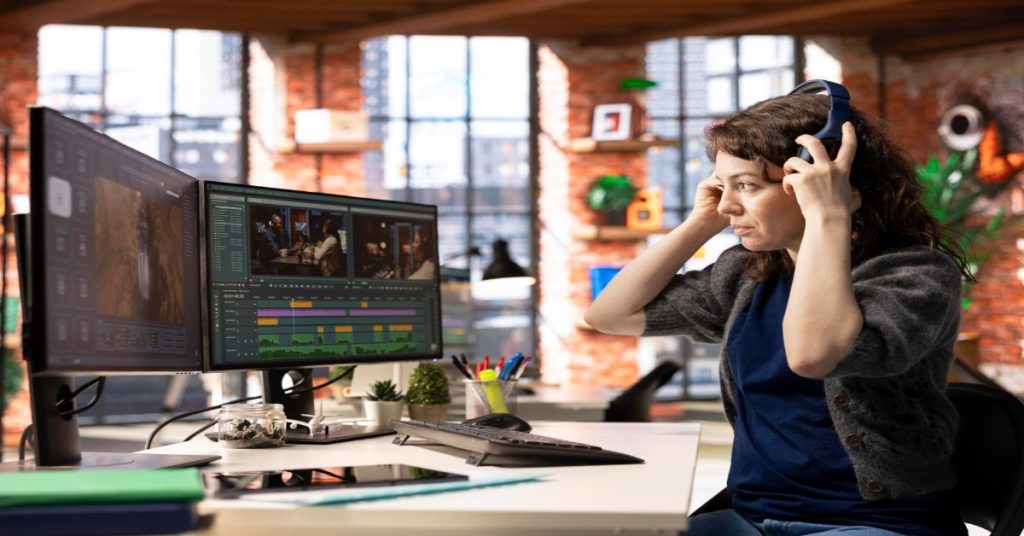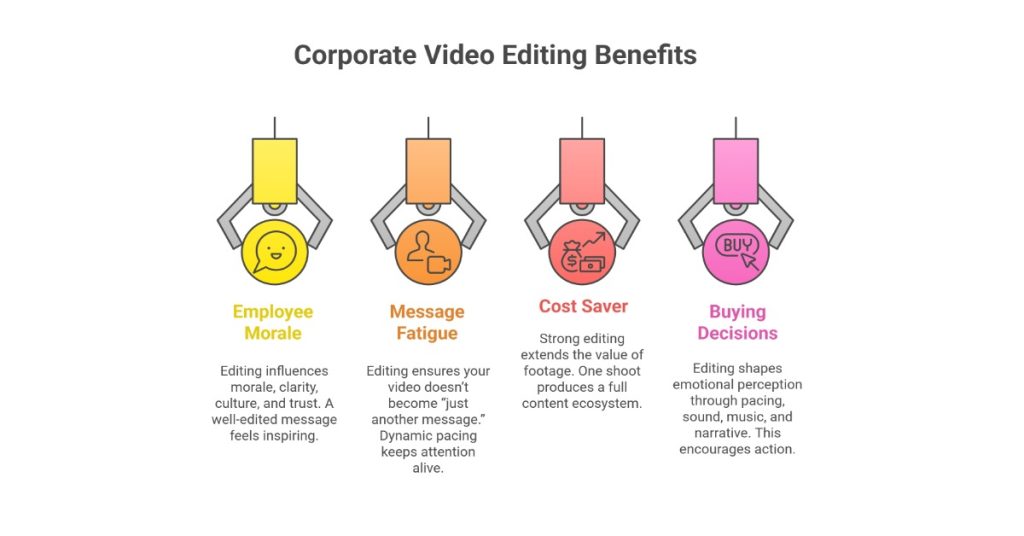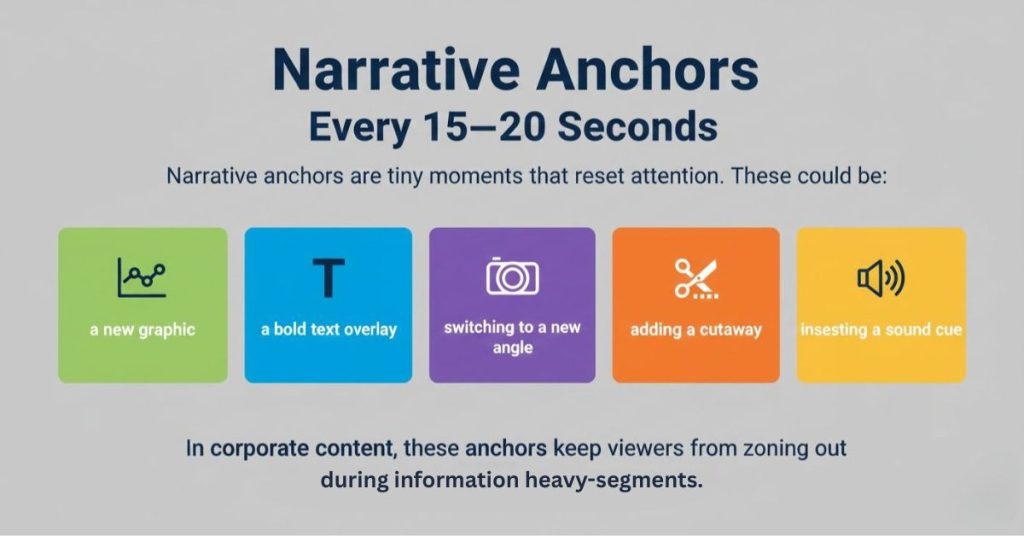Understanding the Importance of Corporate Video Editing for Brands
Video editing is a process that takes a simple idea and brings it to life; shaping the way the audience experiences the message. It is where creativity meets strategy, and it can make or break the success of your content. Effective video editing ensures that every frame, sound and transition enhances the narrative and keeps viewers engaged from start to finish. Since the attention spans are now shorter and competition for audience attention is fierce. That’s why corporate video editing is essential for crafting videos that resonates and leaves a lasting impact.
Corporate brands are using videos more aggressively for training, recruitment, product demos, customer success stories, and internal communication. But producing footage is only half the job. How it’s edited determines whether that content gets watched, understood, and remembered.
Table of Contents
- Why Video Editing Matters More Than Ever for Corporate Brands?
- Corporate Video Editing Is Not Just Cutting Clips
- Unique Corporate Insights: What Most Companies Don’t Realize About Editing
- Data-Backed Perspective: Why Video Editing Drives Results?
- Corporate Video Editing Best Practices: Insights You Won’t Find Everywhere
- Conclusion
- Frequently Asked Questions (FAQs) related to Video Editing
The right corporate video editing choices can elevate your video, turning a good idea into an unforgettable experience. Turning raw footage into a dynamic and compelling video boosts your content’s production value, making it more likely to capture your target audience’s attention.
In this post, we explore why corporate video editing matters, how it shapes narrative and brand perception, and the strategic decisions that can boost engagement and ROI.
Why Video Editing Matters More Than Ever for Corporate Brands?
1. Corporate Messages Are More Complex: Editing Simplifies Them
Corporate videos often need to simplify complicated topics: product workflows, financial updates, tech demos, or company-wide announcements.
A strong corporate video editing strategy breaks complexity into digestible visuals.
- Editors can use cutaways, graphics, and pacing to make dense information feel lighter.
- They can highlight the most important ideas first.
- They could remove unnecessary jargons and visual clutter.
This becomes essential when communicating with global teams, remote employees, or decision-makers.
2. Corporate Audiences Expect Premium Production Value
Employees, clients, and stakeholders watch high-quality content daily on platforms like YouTube, Netflix, and TikTok. Therefore, their expectations for corporate videos have changed. They want:
- clean visuals
- fast pacing
- dynamic graphics
- good sound
- clear storytelling
3. Corporate Brand Consistency Depends on Editing
Unlike consumer content, corporate videos must reinforce brand identity across every asset. Corporate video editing ensures consistency in:
- tone
- color palette
- motion graphics
- typography
- logo treatments
- pacing
A consistent edit builds trust and help stakeholders immediately recognize branded content.

Corporate Video Editing Is Not Just Cutting Clips
1. Crafting a Story, Not Just a Sequence
At its core, video editing is storytelling. A well-edited video weaves together disparate scenes, sound, and pacing into a cohesive narrative. Through the visuals, you have to show what happened and make the viewer feel something.
2. Improving Visual Appeal
Editors use techniques like color grading, motion graphics, and visual effects to enhance the aesthetic quality of a video. These elements convert a simple footage into a polished and professional one.
3. Focusing on the Message
Good editing trims unnecessary content and emphasizes what’s important. This helps in maintaining viewer attention and ensures clarity of the message.
4. Eliciting Emotion
Through carefully timed cuts, transitions, music, and pacing; editors guide the audience’s emotional journey- whether that’s excitement, suspense, empathy, or delight.
5. Reinforcing Brand Identity
Consistent visual style, tone, and structure across videos help build and reinforce brand recognition. Strategic corporate video editing ensures that every piece aligns with your brand values and messaging.
6. Optimizing for Different Platforms
Different platforms (YouTube, LinkedIn, Instagram) demand different editing styles, formats, and lengths. Editors must tailor content according to the platform norms and audience behavior.
7. Polishing and Error Correction
Editing corrects imperfections like stabilizing shaky footage, balancing audio, syncing sound, removing distractions, and fine-tuning everything for a professional finish.
8. Boosting Engagement
Well-edited videos retain viewers longer, provoke interaction, and encourage sharing. All these are critical metrics in video marketing for measuring the success of a video.

Unique Corporate Insights: What Most Companies Don’t Realize About Editing
1. Video Editing Controls How Employees Feel About the Company
Internal videos are one of the most underappreciated branding tools. From onboarding experiences to CEO town halls, editing influences:
- morale
- clarity during organizational changes
- culture perception
- trust in leadership
A well-edited message from leadership feels inspiring. A poorly edited one can feel disconnected or confusing.
Example:
Companies like Envoy Air (American Airlines Group) improved internal alignment significantly after upgrading their video editing and digital signage efforts, improving communication efficiency for dispersed teams. This helped reinforce company culture and improved the effectiveness of their messaging. (Source: AVNetwork).
This proves that videos can impact not just viewers, but entire organizational outcomes.
2. Video Editing Helps Corporate Videos Beat “Message Fatigue”
Employees often receive dozens of internal messages each week. Customers scroll through hundreds of ads a day.
The right edit ensures your video doesn’t become “just another message.” Dynamic pacing, visual storytelling, and strategically placed transitions keep attention alive.
3. Editing Is a Hidden Cost Saver
Strong editing extends the value of footage. With intentional planning, a single shoot can produce:
- a long brand story
- multiple social media clips
- internal training snippets
- reels/shorts
- testimonial highlights
- product teasers
Companies save money because editing turns one shoot into a full content ecosystem.
4. Editing Can Influence Buying Decisions More Than Script or Design
Corporate buyers don’t make purchasing decisions emotionally or one might assume.
But editing shapes emotional perception through:
- pacing
- sound design
- music
- transitions
- narrative structure
These elements guide how a viewer feels about your brand, reliability, and product quality.
This emotional impact subtly encourages action.

Data-Backed Perspective: Why Video Editing Drives Results?
Here are verified insights from industry research:
- Videos increase landing page conversions by up to 80% when edited with strong hooks and clear storytelling. (Source: WordStream)
- Short videos under 2 minutes produce up to 75% higher engagement. (Source: WiFiTalents).
- More than 75% of video consumption now happens on mobile devices, which means proper editing, framing, and formatting for small screens directly affect retention and watch-through rates. (Source: Teleprompter.com)
- Research on short-form video platforms shows significantly higher engagement rates compared with long-form content, with formats like YouTube Shorts gaining more views per video due to algorithmic boosting and shorter consumption times. (Source: arXiv)
These trends emphasize the importance of video editing, which should be concise, intentional, and platform aware.
Corporate Video Editing Best Practices: Insights You Won’t Find Everywhere
1. Always Edit with a “Two-Audience Mindset”
Most corporate videos actually have two audiences:
- Your target viewer (buyers, employees, stakeholders)
- The algorithm (YouTube, LinkedIn, Instagram, internal CMS systems)
Video editing must appeal to both. That means optimizing for:
- retention
- watch time
- clarity
- structure and
- searchability
Very few brands think this way, but it dramatically improves reach and engagement.
2. Use “Narrative Anchors” Every 15–20 Seconds
Narrative anchors are tiny moments that reset attention. These could be:
- a new graphic
- a bold text overlay
- switching to a new angle
- adding a cutaway
- inserting a sound cue
In corporate content, these anchors keep viewers from zoning out during information-heavy segments.

3. Always Edit Multiple Variants for Different Stakeholders
A CEO needs a different edit than a new hire. A procurement officer needs a different edit than a marketing lead. Smart production companies now deliver:
- a full corporate cut
- a leadership-friendly summary cut
- a social media cut
- an internal communications cut
- a sales-enablement cut
This makes videos far more effective across departments.
4. Add “Micro-Personalization” When Possible
With modular editing, corporate videos can include:
- region-specific visuals
- department-specific examples
- customer-segment overlays
This increases viewer relevance without needing a full reshoot.
Conclusion
Behind every effective corporate video lies an editing process that balances creativity with clarity and strategy with emotion.
For corporate brands, video editing elevates visual storytelling, strengthens brand identity, and maximizes business impact across internal and external communication. It’s also critical for reinforcing branding and ensuring consistency across all their video content.
Corporate video editing should always be done in such a way that it communicates your message clearly and conveys emotions effectively. It should also be able to ensure that the content flows seamlessly, with every scene serving a purpose.
When editing is done well, the video becomes capable of conveying a message which people can trust, remember, and act upon.
Read More
Mobile Video Editing Apps That Every Content Creator Should Know
Why Storyboarding & Script Writing Are the Foundation of a Successful Corporate Video?
Short Videos and Reels: Why They’re Dominating Social Media Marketing?
Frequently Asked Questions (FAQs) related to Video Editing
Q1- Why is video editing so important?
Video editing is important because it determines how clearly and professionally a corporate message is delivered. It helps simplify complex information, maintain viewer attention, and ensure the content reflects the company’s brand, tone, and communication goals.
Q2- What is the main point of video editing?
The main point of video editing in corporate settings is to organize and present information in a way that is clear, engaging, and aligned with the company’s objectives. Editing ensures that the message is easy to understand and that every element supports the purpose of the video.
Q3- How important is video editing?
Video editing is extremely important because it often decides whether corporate video is being watched, understood, and trusted. Good editing enhances professionalism, improves internal and external communication, and helps the company deliver messages that resonate with employees, clients, and stakeholders.
Q4- How is editing useful?
Editing is useful because it refines raw footage into a polished message. It removes unnecessary content, clarifies key points, reinforces branding, and tailors the video for different audiences such as employees, customers, or leadership.
Q5- Which is one reason to edit a video?
One main reason to edit videos is to make the message more engaging. With improved pacing, visuals, graphics, and sound; the video becomes more compelling and better suited to capture and retain audience’s attention.
Q6- What is most important in editing?
The most important element in video editing is clarity. The edit must communicate the message efficiently while reinforcing brand identity. This includes choosing the right pacing, visuals, tone, and graphics so that the content is easy to follow and professionally aligned with the company’s standards.
Q7- What is basic video editing?
Basic video editing involves arranging clips, trimming unnecessary parts, adjusting audio, adding simple transitions, and ensuring the video flows logically. In corporate videos, it also includes applying branded elements like logos, colors, and typography to maintain consistency.


